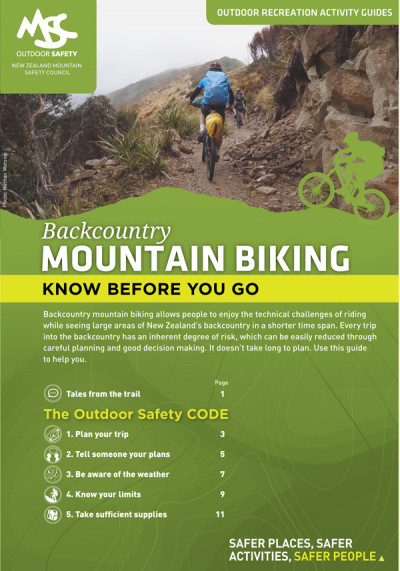STICK TO YOUR LIMITS
While it’s okay to challenge yourself, be sure you’ve doing the right ride for you, in the right conditions, with suitable equipment.
- Do your research – Queenstown's bike trails are incredibly diverse. Not all rides are equal in distance, difficulty and remoteness. Research your mission properly so you know what to expect, and that you have sufficient fitness and experience to complete it.
- Gear up properly – make sure you, your bike and your other gear is up for the specific ride ahead. Read our What to pack section for a gear list and tips.
- Check the weather forecast – Queenstown's climate can be highly unpredictable and downright treacherous should you find yourself on the wrong side of freezing alpine temperatures, or rivers and streams after heavy rain. Always check the forecast, and be ready to change plans if it’s not favourable. Carry more than sufficient gear for the likely conditions, and be prepared to backtrack or bail out out if the weather gets too bad to carry on.
- Check on current track conditions – some sections come with special warnings or are occasionally closed for maintenance; check for current alerts on individual trails.
- Time your ride right – allow plenty of time to complete your ride: rushing or cycling after dark are both recipes for trouble. If possible, shorten your mission, split it over two days, or change it to another day or time when your situation or conditions are more suitable.
- Take care of other riders in your group – not everyone shares the same level of fitness and ability, and nobody likes to be left behind.
Local bike companies, i-SITE staff, accommodation providers and the Department of Conservation are just some of the places you can ask for advice on whether a ride is right for you, and whether now is the best time to do it.
You may also wish to read our Biking Etiquette section, which includes ebiking tips.
TRAIL GRADES
The Queenstown Trail is an easy to intermediate trail with the option of adding in advanced sections. The following descriptions explain the New Zealand Cycle Trail's grading system for riders. We encourage everyone to know your own limits, and choose a trail that suits the abilities of everyone in your group.
EASY / GRADE 2: Off-road trails are predictable, i.e. no surprises and mostly flat with some gentle climbs. The surface is either firm gravel or sealed (e.g. concrete or asphalt). The trail is wide enough for 2 people to cycle side by side at times and may include sections where cyclists will have to ride single file.
Suitable For: Beginners, occasional cyclists and families who have limited cycling experience. A multi-geared bike with medium to wide tyres is recommended, such as a comfort bike, touring bike or mountain bike. E-Bikes are also suitable as long as they are ridden appropriately.
Easy Trails Include: Arrow River Bridges Trail, Frankton Track & Kelvin Peninsula Trail, Gibbston River Trail
INTERMEDIATE / GRADE 3: Off-road trails can be narrow and may include hill climbs, steep drop-offs and small river crossings. The trail surface is mostly firm, but may include muddy or loose sections. There may also be obstacles such as rocks or tree roots to avoid.
Suitable For: Regular, experienced cyclists with a good level of fitness and over 12 years of age. Children should be accompanied by an adult. A mountain bike is recommended for off-road trails. Road racing tyres are not recommended.
Intermediate Trails Include: Countryside Trail, Lake Hayes Trail, Twin Rivers Trail
ADVANCED / GRADE 4: Off-road trails are narrow with steep climbs and unavoidable obstacles. The trail surface includes firm and loose sections, with lots of rocks and tree roots. There will be poor traction in places and some walking may be required.
Suitable For: Fit and experienced cyclists with good off-road skills, a high level of fitness and over 12 years of age. Children should be accompanied by an adult. A quality mountain bike is recommended for off-road trails. Road racing tyres are not recommended.
Advanced Trails Include: Jack's Point Trail
MAPS & NAVIGATION
Although most sections of the Queenstown Trails are well signposted, a map will eliminate any second-guessing and help time your ride for shuttle pick-ups etc. It will also help you identify landmarks, adding even more interest to your ride.
Printed and/or downloadable maps are available for Queenstown Trail, along with other printed and digital maps such as Kennett Brothers guidebooks, KiwiMaps, NZTopomaps, and the Great Rides App.
If you’re venturing on to more remote rides, a more detailed map is recommended, but you may wish to carry an electronic navigational aid, too.
- Your cellphone GPS will work as long as there is good cellphone coverage and decent weather. Consider downloading NZTopomaps as a base layer.
- A cycle computer is a reliable and relatively cheap navigational aid, particularly when used with detailed ride descriptions such as those in the Kennett Brothers guidebooks or the cue sheets (turn-by-turn guides) commonly used in bikepacking events. The battery life of a cycle computer is more than a year.
- A GPS attached to your handlebars will make it pretty hard to get lost, especially if it’s loaded with up-to-date gpx files for your ride. If such files aren’t available, it’s still valuable for showing your position, although don’t count on it showing recently constructed cycle trails or every backroad. Garmin brand units are waterproof and robust, and can be operated in the wet.
Suffice to say, such devices won’t work with flat batteries, so ensure you’ve got spares or the ability to charge it up, and consider turning it off when not in use, to save power.
STAY IN CONTACT
- Always tell someone where you’re going – a family member, friend, accommodation provider or bike hire operator. Let them know what track you’re riding and when you plan to be back.
- Carry a fully charged cellphone – you may not get reception the whole way, but you may be able to find a spot to get a call through in an emergency.
- For more remote rides, consider taking a personal locator beacon (PLB) or satellite tracker – available to buy or hire.
- Whatever tracking device you take, keep it on your person rather than on your bike just in case you get separated from your bike in a crash.
Visit the Mountain Safety Council website for lots more useful information about communication in the outdoors.
BE SAFE ON THE ROAD
If you’re cycling on the road, you need to know the road rules. The Official New Zealand Code for Cyclists, developed by the New Zealand Transport Agency, is a user-friendly guide to New Zealand’s traffic law and safe driving/cycling practices.
Here are some basic tips to know and share.
- Be seen – wear high visibility or brightly coloured clothing. Use front and rear lights at night, in low light and in poor visibility such as fog or rain.
- Be aware – watch and listen for approaching vehicles, pedestrians, potholes, animals, car doors opening and other potential hazards.
- Be predictable – make eye contact with other road users. Maintain a straight line, keep to the left and signal your intentions clearly and early.
- Be confident – know how to safely approach railway crossings, roundabouts and intersections etc. Use hand signals to indicate your intentions and a bell to alert other road users to your presence.
- Be safe – ride to the conditions and follow the road rules. Cycle no more than two abreast and ride single file where visibility is an issue or traffic is busy. Keep at least one metre away from parked cars and use cycle lanes where they exist.
- Be patient – slow down near parked or queuing vehicles. Pass slowly and only when safe. On narrow windy roads, pull over where practical to allow vehicles to pass.
- Be prepared – wear an approved helmet and check your bike regularly. Plan your route and carry sufficient water and food, along with basic tools for any repairs.
BACKCOUNTRY MOUNTAIN BIKING GUIDE
We’ve developed a guide with the NZ Mountain Safety Council to help you plan for your trip into New Zealand’s outdoors. Download and read the Backcountry Mountain Biking guide; it has all you need to KNOW BEFORE YOU GO, from trip planning and what to take, to the skills you need on the track and how to keep properly fuelled.




